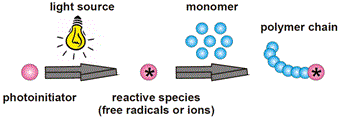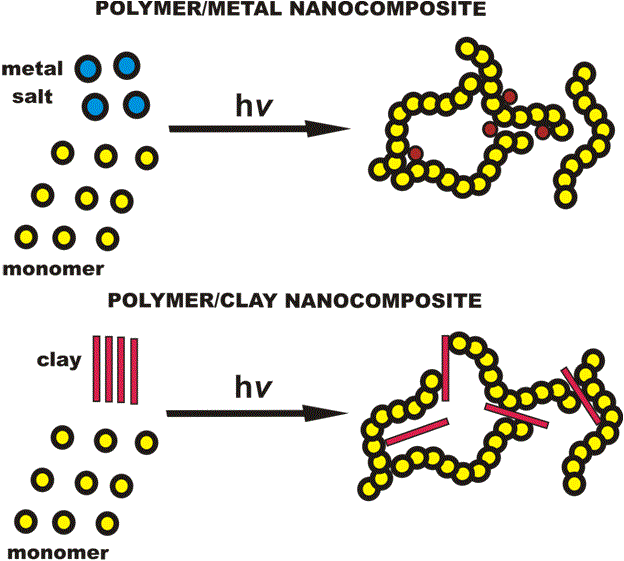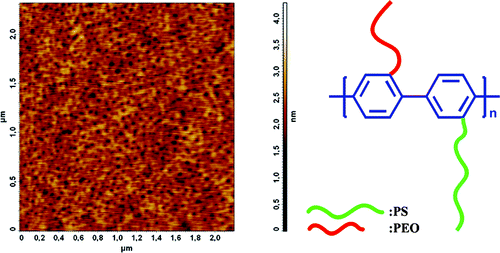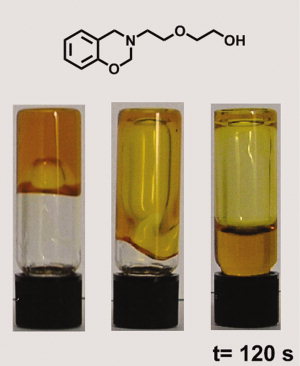
PHOTOPOLYMERIZATION
Photoinitiated polymerization is usually referred to as a chain process that is initiated by light and both the initiating species and the growing chain ends are radicals and cations, and in some cases, anions or weak bases.
 Photopolymerization of monofunctional monomers
Photopolymerization of monofunctional monomers
Photopolymerization of bifunctional monomers
NANOCOMPOSITES
 Nanocomposite
materials containing metal nanoparticles and polymer matrix may
exhibit novel physical and chemical properties that are of high
scientific and technological importance. These materials combine
the physical properties of small size metal nanoparticles with
those of polymeric materials in a beneficial manner. Many
advanced optoelectronic and sensor devices are based on the
fabrication of these materials. Additionally, polymer-layered
clay nanocomposites receive interest beacuse of their improved
physical and chemical properties due to small size or large
surface area of the clay with nanoscale dimension. Although many
methods have been tested, the dispersing in situ polymerization
may be the most desirable method for preparing nanocomposites
because the types of nanoparticles and the nature of polymer
precursors can be selected. Photopolymerization methodology
allows in situ synthesis of polymer nanocomposites using
organophilic montmorillonite (MMT) as the layered clay.
Nanocomposite
materials containing metal nanoparticles and polymer matrix may
exhibit novel physical and chemical properties that are of high
scientific and technological importance. These materials combine
the physical properties of small size metal nanoparticles with
those of polymeric materials in a beneficial manner. Many
advanced optoelectronic and sensor devices are based on the
fabrication of these materials. Additionally, polymer-layered
clay nanocomposites receive interest beacuse of their improved
physical and chemical properties due to small size or large
surface area of the clay with nanoscale dimension. Although many
methods have been tested, the dispersing in situ polymerization
may be the most desirable method for preparing nanocomposites
because the types of nanoparticles and the nature of polymer
precursors can be selected. Photopolymerization methodology
allows in situ synthesis of polymer nanocomposites using
organophilic montmorillonite (MMT) as the layered clay.


TRANSFORMATIONS REACTIONS
The synthesis of block copolymers between structurally different polymers i.e. condensation and vinyl polymers, by a single polymerization method is rather difficult due to the nature of the respective polymerization mechanisms. Furthermore, utilization of a single method often excludes monomers that polymerize by other mechanisms. In order to extend the range of monomers for synthesis of block copolymers, transformation approach was postulated by which the polymerization mechanism could be changed from one to another which is suitable for the respective monomers. Transformation reactions are classified on the basis of interconversion between propagation mechanisms. It can be seen that between the main living and controlled/living polymerization methods, transformations are accessible in both directions.


BLOCK and GRAFT
COPOLYMERIZATION
 Block
and graft copolymers are the most demanded advanced materials
because of their diverse copolymer structures. In most cases,
the corresponding homopolymers do not form homogeneous phase.
However, linear arrangement of the blocks by chemical bonds
results in the realization of a stable structure with two phases
separated. Each segment exerts its character or function to the
bulk of the copolymers. This way various properties are improved
or combined to give possibility of using block copolymers as
compatabilizers, impact modifiers, surface modifiers, coating
materials, antistatic agents and adhesives.
Block
and graft copolymers are the most demanded advanced materials
because of their diverse copolymer structures. In most cases,
the corresponding homopolymers do not form homogeneous phase.
However, linear arrangement of the blocks by chemical bonds
results in the realization of a stable structure with two phases
separated. Each segment exerts its character or function to the
bulk of the copolymers. This way various properties are improved
or combined to give possibility of using block copolymers as
compatabilizers, impact modifiers, surface modifiers, coating
materials, antistatic agents and adhesives.


CONTROLLED POLYMERIZATION METHODS
Recent developments in controlled/living radical polymerization provided possibility to synthesize well-defined telechelic polymers with controlled functionality also with radical routes. As it will be shown below, all the three standard methods for controlled/living radical polymerization, namely, Atom Transfer Radical Polymerization (ATRP), Stable Free Radical Mediated Polymerization (SFRP), also called as Nitroxide Mediated Polymerization (NMP), and Reversible Addition-Fragmentation Chain Transfer Polymerization (RAFT) were used for the preparation of telechelic polymers.


CLICK CHEMISTRY
On the other hand, blocks of polymers synthesized by distinct polymerization mechanisms can be combined by special reactions such as “click” reactions. In such coupling process, a pair of antagonist groups such as azide-alkyne or anthracene-maleimide that react with other antagonist of pair on the other polymer chain. In other words, the coupling reaction occurs via specially prepared groups introduced to chain end rather than active sites of the living polymers and therefore named as indirect coupling. The antagonist groups can be attached onto polymers by post modification or utilization of heterofuntional initiators.

|
CONJUGATED POLYMERS
There is a long interest to prepare soluble conjugated polymers so that polymerization, purification, characterization and processability to be carried out in solution, polymers to be free defects, with a known structure and to form thin films. Owing to their intrinsic chemical structure, conjugated polymers are insoluble in most organic solvents and improving their solubility and processability has been became an important objective that focused many research efforts. From the chemistry viewpoint this disadavantage could be surpassed by design of adequate monomers and introduction of solubilizing side chains onto the conjugated backbone is a very used and efficient method for solubility improving. read more
|

|
BENZOXAZINE BASED THERMOSETS
Among various high performance materials, polybenzoxazine, as a recently developed thermosetting phenolic resin, has received much interest for its unique characteristics such as heat resistance, good flame retardance, low moisture absorption, good mechanical properties and excellent dimensional stability. read more
|
![]()

|
In the last few years incorporations of
a side-group liquid crystalline (LC)
polymer with another non-LC polymer into
various forms of LC AB-type block
copolymers have made it possible to
access a new wide range of structure and
property combinations.
|
read more
![]()

|
Electrically conducting polymers have received growing interest because of their wide range applications in the areas such as rechargeable batteries, membranes, optical displays, and electro chromic devices. These materials are often termed as synthetic metals due to the fact that they combine chemical and mechanical properties of the polymers with the electronic properties of the metals and semicunductors. Polythiophene is one of the polymers among a general type of conducting polymers that include polyacetylenes, polypyrrole, polyanilines, polyphenylenes, polycarbazoles, polyquinolines, and polyphtalocyanines. read more
|


